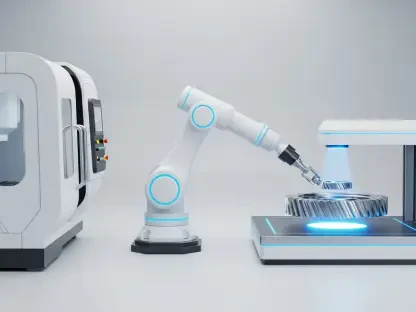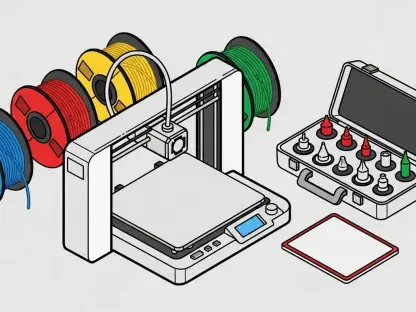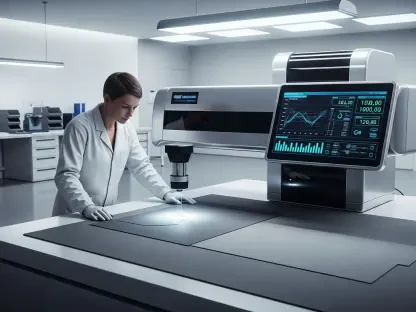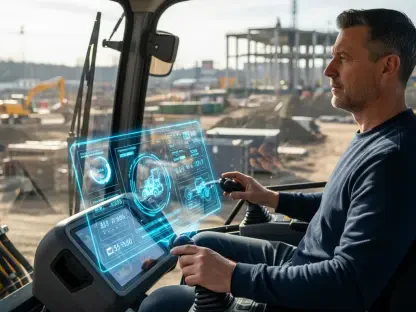The Global Industrial Robotics Services Market is undergoing a significant transformation, driven by rapid advancements in automation technologies and increasing adoption across various industries. This evolution presents new opportunities and challenges for businesses and stakeholders in the field. The market, which includes deployment, maintenance, and training for robotic systems, is expanding at an unprecedented rate, promising substantial benefits for industries like automotive, electronics, food and beverage, and aerospace. This article delves into the current status, future growth projections, key players, segmentations, and market dynamics shaping this evolving market.
Market Overview and Growth Projections
Current Market Status
The industrial robotics services market, which includes various essential services such as deployment, maintenance, and training for robotic systems, is currently valued at $20 billion as of 2024. The market is experiencing robust growth driven by the increasing need for automation in numerous industries. Sectors like automotive, electronics, food and beverage, and aerospace are at the forefront of adopting industrial robotics. Automation within these sectors helps enhance operational efficiency, reduce human error, and elevate productivity. These improvements have created a strong demand for industrial robotics services, thereby fostering the market’s growth prospect.
Moreover, the integration of robotic systems has played a crucial role in maintaining competitiveness within these industries. Companies are increasingly relying on automation to meet the escalating demand for higher production rates and improved quality control. This trend has led to a surge in the installation and maintenance of robotic systems, contributing significantly to the current market valuation. As businesses recognize the benefits of robotic integration, the adoption rate is expected to continue soaring, further solidifying the market’s uptrend.
Future Growth Projections
According to the HTF Market Intelligence report, the industrial robotics services market is projected to grow significantly, reaching an estimated valuation of $45 billion by 2032. This impressive growth is attributed to a compound annual growth rate (CAGR) of 8.5%. A major driving force behind this booming growth is the increased penetration of industrial automation, particularly in the Asia-Pacific (APAC) region. Countries like China, Japan, and South Korea are spearheading this trend, establishing themselves as leaders in industrial automation.
The APAC region boasts a strong manufacturing base, supported by advanced technological infrastructure, attracting substantial investments in industrial robotics. This thriving environment fosters continuous advancements and the widespread adoption of state-of-the-art robotic systems. The increasing need for cost-effective manufacturing and high-precision production processes will continue to propel the market’s growth. Additionally, governmental initiatives aimed at boosting manufacturing output and modernizing industrial capabilities further stimulate market expansion in the APAC region.
Key Players in the Market
Leading Companies
Prominent companies driving the industrial robotics services market include FANUC, ABB, KUKA, Yaskawa Electric, Mitsubishi Electric, and Kawasaki Heavy Industries. These key players play a central role in the market’s development, leveraging their expertise and resources to push the boundaries of robotics technology. They focus heavily on innovations such as collaborative robots (cobots) and AI-driven robotics to provide greater flexibility and efficiency in manufacturing processes. Cobots, designed to work safely alongside human operators, offer new possibilities for automation in diverse environments, promoting a harmonious coexistence between humans and machines.
These companies continuously invest in research and development to stay ahead of the competition and meet the evolving needs of their clients. They engage in strategic partnerships and collaborate with technology providers, research institutions, and other stakeholders to foster innovation and drive the market forward. By introducing cutting-edge robotic solutions and enhancing the capabilities of existing systems, these industry leaders are poised to capture a significant share of the growing market.
Innovations and Strategies
To maintain their competitive edge, leading companies in the industrial robotics services market are actively innovating and employing a range of strategic initiatives. These strategies include strategic agreements, expansions, new product launches, and acquisitions. By forging alliances and partnerships, they enhance their market reach and diversify their product offerings. Expansions into new geographical regions and market segments enable them to tap into emerging opportunities and cater to a broader customer base.
New product launches are another key strategy, allowing companies to introduce advanced robotic solutions tailored to specific industry requirements. These latest innovations often incorporate AI and machine learning, enabling predictive maintenance and optimizing operational efficiencies. Acquisitions of smaller technology firms and startups help established players gain access to novel technologies and enhance their capabilities. Collectively, these strategies bolster the market position of key players, ensuring they meet the rising demand for automation solutions in a dynamic and competitive landscape.
Market Segmentation
Service Types
The industrial robotics services market is segmented into four primary service types: installation, maintenance, training, and reconditioning. Installation services are critical, involving the initial setup and programming of robotic systems to ensure they operate as intended within the manufacturing environment. This process requires meticulous planning and execution to integrate the robotic systems seamlessly into existing workflows. Companies offering installation services play a vital role in the successful deployment of robotics, ensuring that the systems are tailored to meet specific customer needs.
Maintenance services are equally important, encompassing regular and preventive upkeep to ensure that robotic systems continue to function efficiently over time. Maintenance activities include troubleshooting, repair, and upgrades to enhance system performance and longevity. These services help prevent unexpected downtime and maintain operational continuity, which is essential for industries with high production demands. Additionally, training services equip users with the necessary skills to operate and manage robotic systems proficiently. Comprehensive training programs cover system operation, safety protocols, and troubleshooting, empowering users to maximize the benefits of robotic integration.
Application Segments
The application segment of the industrial robotics services market is diverse, reflecting the wide-ranging utility of robotic systems across various industries. The automotive industry, a stronghold for industrial robotics, relies heavily on these systems for manufacturing processes such as welding, assembly, and painting. Robotics in the automotive sector enhances precision, reduces labor costs, and accelerates production rates, making it a cornerstone of modern manufacturing.
The electronics industry is another significant user of robotic systems, employing them for tasks that demand high precision and efficiency. Robotics aid in assembly, testing, and quality control of electronic components, ensuring high standards of accuracy and reliability. In the food and beverage industry, robotics are used for packaging, sorting, and quality inspection, streamlining processes and ensuring product consistency. The aerospace sector utilizes robotic systems for assembling and inspecting critical components, leveraging their precision and reliability to maintain stringent quality standards. These diverse applications highlight the market’s extensive scope and the pivotal role of robotics in modern industry.
Geographical Breakdown
North America and Europe
North America remains a major player in the industrial robotics services market, driven by advanced technological adoption and a robust manufacturing base. The United States, Canada, and Mexico are key contributors to the market’s growth in this region. The presence of leading technology firms and extensive research and development activities bolster market expansion. North American companies are at the forefront of integrating cutting-edge robotics and automation solutions into their manufacturing processes, setting industry standards for innovation and efficiency.
Europe also continues to expand its automation capabilities, with significant markets in Germany, France, Italy, and the UK. European companies are known for their engineering excellence and commitment to quality, driving the adoption of sophisticated robotic systems. The region’s strong industrial base, coupled with supportive government policies and investment in smart manufacturing, fosters a conducive environment for market growth. European manufacturers are increasingly adopting robotics to address labor shortages, improve production efficiency, and maintain competitiveness on a global scale.
Asia-Pacific and Other Regions
The Asia-Pacific (APAC) region is highlighted as the fastest-growing area in the industrial robotics services market, driven by increasing industrial automation in countries like China, Japan, and South Korea. These countries have established themselves as leaders in manufacturing, supported by a strong technological infrastructure and a skilled workforce. The rapid pace of industrialization and the adoption of advanced automation technologies in APAC are key factors propelling market growth.
Other regions, such as Latin America, Central & Eastern Europe, Northern Europe, Southern Europe, East Asia, Southeast Asia, South Asia, Central Asia, Oceania, and the Middle East and Africa (MEA), also contribute to the market’s expansion. These regions are witnessing a growing interest in automation as businesses seek to enhance productivity, reduce operational costs, and improve product quality. The development of local manufacturing industries and the increasing acceptance of robotic solutions in diverse applications further drive the market’s global growth trajectory.
Key Trends Influencing the Market
Integration of AI and Machine Learning
The integration of artificial intelligence (AI) and machine learning (ML) into robotic systems is a key trend significantly influencing the industrial robotics services market. These advancements enable the development of smarter and more autonomous robotic systems capable of performing complex tasks with minimal human intervention. Predictive maintenance, powered by AI and ML, allows for the early detection of potential issues, optimizing operational efficiencies and reducing downtimes. This proactive approach ensures that robotic systems operate at peak performance, enhancing overall productivity and cost-effectiveness for businesses.
Moreover, AI-driven robotics can adapt to changing environments and learn from their experiences, paving the way for greater flexibility and adaptability in manufacturing processes. These intelligent systems can analyze vast amounts of data and make informed decisions, improving operational workflows and maintaining high standards of quality control. The continued integration of AI and ML into robotics is expected to drive further innovation and unlock new possibilities for industrial automation, reinforcing the market’s growth and transformation.
Rise of Collaborative Robots (Cobots)
The rise of collaborative robots, commonly known as cobots, is transforming the industrial robotics services market by allowing more flexible and adaptive manufacturing environments. Cobots are designed to work safely alongside human operators, enhancing productivity and fostering a collaborative work environment. Their ability to perform repetitive and physically demanding tasks relieves human workers, enabling them to focus on more complex and value-added activities. This synergy between humans and robots leads to greater efficiency and improved job satisfaction.
Cobots provide significant advantages, including ease of deployment, versatility, and cost-effectiveness. Unlike traditional industrial robots, cobots do not require extensive safety barriers, reducing the cost and complexity of installation. Their intuitive programming interfaces and user-friendly design make them accessible to a wider range of industries, including small and medium-sized enterprises. The versatility of cobots allows them to be reprogrammed and reassigned to different tasks, providing a flexible and scalable automation solution. As businesses increasingly recognize the benefits of cobots, their adoption is expected to rise, further driving market growth and innovation.
Market Dynamics
Analytical Frameworks
The market dynamics of the industrial robotics services sector involve a comprehensive analysis considering various factors through frameworks such as Porter’s Five Forces and PESTLE analysis. These analytical frameworks provide valuable insights into the competitive landscape and the external factors influencing the market. Porter’s Five Forces analysis examines the bargaining power dynamics among buyers and suppliers, the threats posed by new entrants and substitutes, and the level of competitive rivalry within the market. This analysis helps identify strategic opportunities and challenges, guiding businesses in their decision-making processes.
PESTLE analysis, on the other hand, scrutinizes the political, economic, social, technological, legal, and environmental factors impacting the market. For instance, regulatory policies and governmental support for automation play a crucial role in shaping the market environment. Economic conditions, such as GDP growth and industrial investment, influence market demand and growth prospects. Social and demographic trends, including workforce availability and skill levels, affect the adoption and implementation of robotic systems. Technological innovations drive the development of advanced robotic solutions, while legal frameworks and environmental considerations ensure compliance and sustainability. These comprehensive analyses provide a holistic understanding of the market dynamics, enabling stakeholders to anticipate trends and make informed strategic decisions.
Influential Factors
Several influential factors significantly impact the industrial robotics services market, shaping its trajectory and growth potential. Political factors, such as government policies and initiatives, play a vital role in promoting automation and fostering a conducive business environment. Economic factors, including industrial investment, labor costs, and productivity demands, drive the adoption of robotic systems. Social factors, like changing workforce demographics and attitudes towards automation, also influence market growth.
Technological factors are pivotal, with advancements in robotics, AI, and machine learning driving innovation and expanding the capabilities of robotic systems. Legal factors, including regulatory standards and compliance requirements, ensure the safe and ethical use of robotics in industrial settings. Environmental factors, such as sustainability trends and the push for green manufacturing, encourage the development of energy-efficient and eco-friendly robotic solutions. These diverse factors interact to shape the market dynamics, presenting opportunities and challenges for businesses operating in the industrial robotics services sector.
Conclusion
The Global Industrial Robotics Services Market is undergoing a remarkable transformation, fueled by rapid advancements in automation technologies and a surge in adoption across various industries. This shift creates new prospects and challenges for businesses and stakeholders within the sector. Encompassing deployment, maintenance, and training for robotic systems, the market is growing at an unprecedented pace, promising significant advantages for industries such as automotive, electronics, food and beverage, and aerospace.
This article thoroughly examines the current status, future growth forecasts, major players, segmentations, and market dynamics shaping this evolving landscape. With the increasing complexity of industrial processes, the demand for skilled robotics services is at an all-time high. Businesses are investing heavily in these technologies to enhance efficiency, reduce operational costs, and stay competitive in the global market. As this sector continues to evolve, it will be crucial for companies to stay abreast of the latest developments and leverage these advancements to achieve long-term success.









